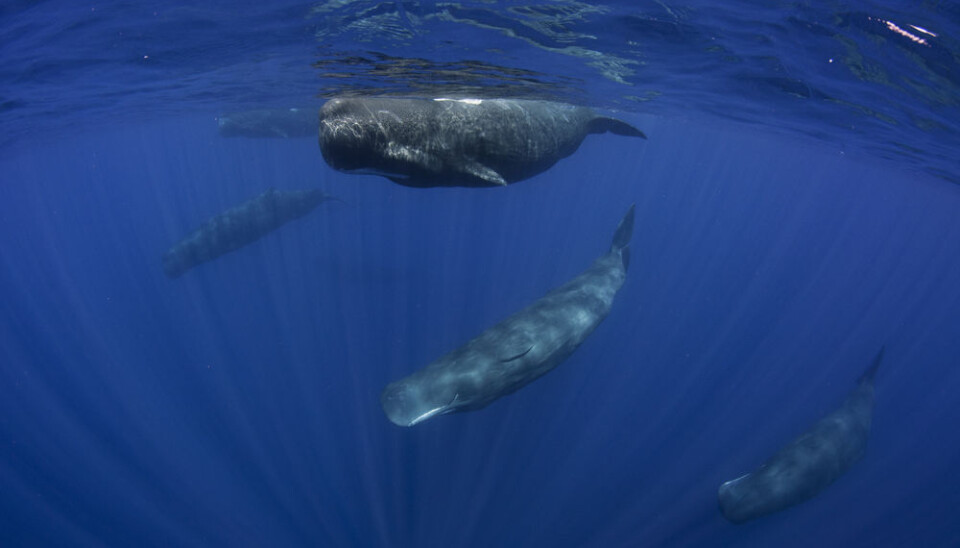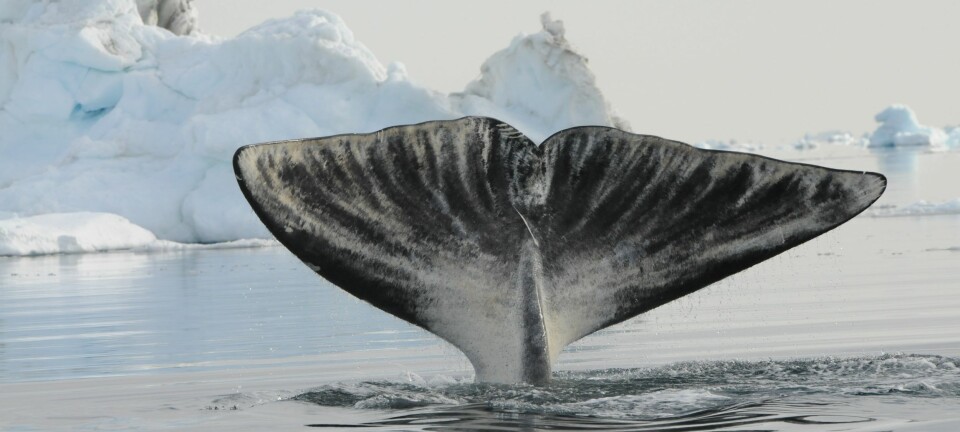
Sperm whale language under scrutiny
A new project aims to decode the sperm whale’s communication system using the latest animal-borne acoustic technology.
For the first time ever, a research project has set out to study and connect all the various components that make up the sperm whale’s communication – its natural sounds and language, movements and its general behaviour.
Scientists already know that sperm whales have a common language as well as individual dialects, which they use to identify where they come from.
The individual clicking sounds that make up the whales’ language will now be put into a greater context, along with their physical behaviour when they communicate.
The studies will be carried out off the island of Dominica in the Caribbean Sea, where there are some 400 sperm whales. The scientists will be conducting a detailed study of 4-5 of these whales, which all belong to the same family group.
Whales travel together from the surface into the deep sea

The project is only possible thanks to the very latest technological equipment from Aarhus University, Denmark, together with the expertise of Canadian researcher Shane Gero, who has spent a decade studying sperm whale families up close in the Dominica Sperm Whale Project. This has taught him a great deal about the whales’ social behaviour, family groups, movement patterns, individual DNA and the whales’ general communication.
”We are now able to record sound waves from the whales all the way from the surface into the deep sea while they rest, communicate with their young or warn their family group of danger,” says Gero, who will be spending the next two-and-a-half years leading the project as a postdoctoral fellow at Aarhus University’s Department of Bioscience, Zoophysiology section.
The fieldwork at sea will take place in April and May of this year and in 2015.
New equipment measures more than just whale language
From a small boat, Gero and colleagues are planning to fit an acoustic measurement kit on the backs of the whales when they are near the surface. This will be done using a 10-metre long pole.
Click-click-click-click-click. These five clicking sounds in rapid succession are characteristic of all sperm whales regardless of where in the world they live. On the other hand, there is the ‘Click-click … click-click-click’ sound, which is more individual and can also be emitted in a variety of strengths and frequencies.
The acoustic measurement kit uses accelerometers, magnetometers and pressure sensors to measure movements, speeds and depths, and it measures the whales’ positions as well as the sounds they emit.
”The whales do not feel the 200-gram instruments that we stick onto their backs and which come off after 48 hours. When the kit has come loose, it emits a radio signal, which enables us to locate it. We extract the data and then we can reuse these so-called DTAGs on other whales,” says Gero.
So far, the main focus has been on the whales’ communication when they respond to sounds from humans, for instance when air guns are fired off in connection with oil and gas exploration at sea, or when the whales are affected by the sonar systems in submarines.
Sperm whales are capable of acoustic location
The new project will take a detailed look at the sperm whale’s different forms of communication. The researchers already know that sperm whales have different forms of expression, depending on the situation and the location:
The whales use one form of linguistic expression when they present themselves as a cultural group – i.e. when they express that they come from e.g. the Caribbean or the Atlantic Ocean, and another when they communicate within their own family or when they express themselves as individuals.
”The whales use one form of linguistic expression when they present themselves as a cultural group – i.e. when they express that they come from e.g. the Caribbean or the Atlantic Ocean, and another when they communicate within their own family or when they express themselves as individuals.”
Gero gives an example of the clicking sounds, known as ‘codas’, which are similar to Morse code:
“Click-click-click-click-click. These five clicking sounds in rapid succession are characteristic of all sperm whales regardless of where in the world they live. On the other hand, there is the ‘Click-click … click-click-click’ sound, which is more individual and can also be emitted in a variety of strengths and frequencies.”
He compares this with the cultural differences in human language: a person’s family ties are all important in e.g. Japan, which is why the Japanese say the surname first, whereas Danes primarily regard themselves as individuals and therefore start out with their first name.
One of the loudest noises in the animal kingdom
When sperm whales are on or near the sea surface, they use their ‘Morse language’; when they dive down to the depths, they use echolocation:
”When they dive down to hunt for their primary food source, deep-sea octopuses, they switch over to echolocation. This is their main weapon down in the dark depths where their eyesight is of little use. The sperm whale’s echolocation sounds are emitted as a kind of shot sound effect at a very narrow angle and can detect octopuses from a distance of up to 500 metres,” says Gero.
This sound has one of the highest decibel levels in the animal kingdom – and the most powerful sonar system of them all.
Whales have dialects and family language
For optimal results, it is important that the researchers learn about the whale families in advance, so they can identify as many of them as possible.
”I have spent many years observing the whales with binoculars from small boats and I have taken photos of their fins in order to identify them. I have collected exfoliated skin flakes from which we have taken DNA samples. We have also collected faecal samples, which contain information about food consumption,” says the researcher.
”Sperm whales live in dense flocks of up to 14 members consisting solely of females and cubs. This is why their most commonly used language is the family language. We will be listening in on and interpreting the finer nuances of the whales’ language while they are resting, calling for their cubs, signalling danger, etc.”
Shane Gero believes that the findings and the methods of his project, titled ‘Contextual Use of Vocal Communication among Sperm Whales’, will also be useful for research into the communication and behaviour of other animal species.
--------------------
Read the Danish version of this article at videnskab.dk







